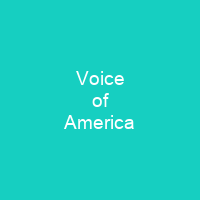What is Voice of America (VOA)? Voice of America (VOA) is a giant in international broadcasting, funded by the U.S. federal government and operating since 1942. Its mission is to inform and engage non-American audiences through content produced in 48 languages. Headquartered in Washington, D.C., VOA broadcasts via affiliate stations worldwide, reaching an estimated 326 million adults as of November 2022.
Established during World War II, VOA initially focused on countering Nazi propaganda with American jazz and news programs. Over the decades, it has evolved to include radio, television, and digital platforms, adapting to changing technologies and geopolitical landscapes.
The Evolution of Voice of America
From Radio to Television: In the 1980s, VOA expanded its services by adding television broadcasts. The network also covered significant events like Martin Luther King Jr.’s ‘I Have a Dream’ speech and Neil Armstrong’s moonwalk.
Post-Cold War Challenges
Cutting Costs: In the 1990s, VOA faced budget cuts, leading to the elimination of several language services. By 2002, it had reduced its offerings significantly due to financial constraints.
Russia and International Scrutiny
Restrictions and Blockages: In recent years, Russia has blocked VOA broadcasts, citing censorship. The network also faced scrutiny in Turkey for not complying with local directives intended to enable censorship.
The Future of Voice of America
Political Influence: Under the Trump administration, VOA faced accusations of politicization and bias. Michael Pack’s tenure as administrator was marked by controversy over his policies and appointments.
Current Challenges: In 2025, Kari Lake was proposed as a potential director for VOA, but her appointment faces scrutiny from the International Broadcasting Advisory Board. The network continues to navigate political pressures while striving to maintain its mission of informing global audiences.
Impact and Perception
Positive vs. Negative Views: Some listeners view VOA as a positive force in diplomacy, providing valuable information. Others see it as American propaganda, questioning its objectivity and intentions.
The future of Voice of America remains uncertain, with ongoing debates about its role in international broadcasting and the challenges it faces in an increasingly complex global media landscape.

You want to know more about Voice of America?
This page is based on the article Voice of America published in Wikipedia (retrieved on March 15, 2025) and was automatically summarized using artificial intelligence.







